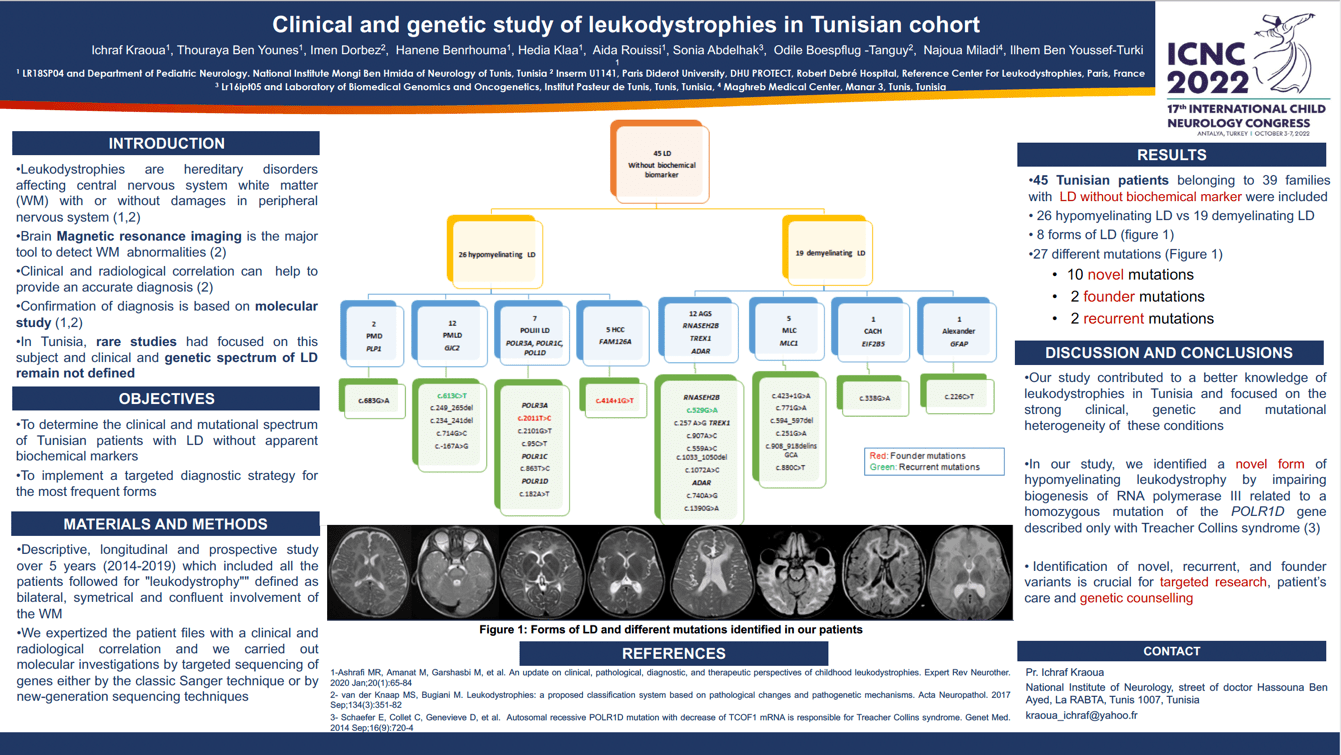Clinical and genetic study of leukodystrophies in Tunisian cohort
Ichraf Kraoua, Thouraya Ben Younes, Imen Dorboz, Hanene Benrhouma, Hedia Klaa, Aida Rouissi, Sonia Abdelhak, Odile Boespflug –Tanguy, Najoua Miladi, Ilhem Ben Youssef-Turki
Objectives : to determine the clinical and mutational profile of Tunisian patients with Leukodystrophy (LD) without apparent biochemical markers and to implement a targeted diagnostic strategy for the most frequent forms. Methods: descriptive, longitudinal and prospective study over 5 years (2014-2019) which included all the patients followed for "leukodystrophy"" defined as bilateral, symetrical and confluent involvement of the WM. We expertized the patient files with a clinical and radiological correlation and we carried out molecular investigations by targeted sequencing of genes either by the classic Sanger technique or by new-generation sequencing techniques. Results: 45 patients belonging to 39 families were genetically confirmed and analyzed in our study. Among the 8 forms of LD, four were hypomyelinating LD (Pelizaeus Merzbacher disease by mutation of the PLP1 gene (2 cases); Pelizaeus Merzbacher-like disease by mutation of the GJC2 gene (12 cases); leukodystrophies linked to polymerase III by mutations of the POLR3A (5 cases), POLR1C (1 case) and POLR1D (1 case) genes and hypomyelination with congenital cataract by mutations of the FAM126A gene (5 cases) and four demyelinating LDs (Aicardi Goutières syndrome by mutation RNASEH2B (6 cases), TREX1 (4 cases) and ADAR (2 cases); Megalencephalic Leucoencephalopathy with subcortical cysts by mutation of the MLC1 gene (5 cases); CACH/VWM syndrome by mutation of the EIF2B5 gene (1 case) and Alexander's disease by mutation of the GFAP gene (1case)). Conclusion: our study contributed to a better knowledge of leukodystrophies in Tunisia and focused on the strong clinical, genetic and mutational heterogeneity of these conditions.
Keywords: Leukodystrophies, MRI, Sanger, NGS, Tunisia
Ichraf Kraoua
National Institute Mongi Ben Hmida of Neurology
Tunisia
Thouraya Ben Younes
National Institute Mongi Ben Hmida of Neurology
Tunisia
Imen Dorboz
Inserm U1141, Paris Diderot University, DHU PROTECT, Robert Debré Hospital, Paris, France
France
Hanene Benrhouma
National Institute Mongi Ben Hmida of Neurology
Tunisia
Hedia Klaa
National Institute Mongi Ben Hmida of Neurology
Tunisia
Aida Rouissi
National Institute Mongi Ben Hmida of Neurology
Tunisia
Sonia Abdelhak
Institut Pasteur de Tunis, Tunis, Tunisia
Tunisia
Odile Boespflug –Tanguy
Inserm U1141, Paris Diderot University, DHU PROTECT, Robert Debré Hospital, Paris, France
France
Najoua Miladi
Tunisia
Ilhem Ben Youssef-Turki
National Institute Mongi Ben Hmida of Neurology
Tunisia
Objectives : to determine the clinical and mutational profile of Tunisian patients with Leukodystrophy (LD) without apparent biochemical markers and to implement a targeted diagnostic strategy for the most frequent forms. Methods: descriptive, longitudinal and prospective study over 5 years (2014-2019) which included all the patients followed for "leukodystrophy"" defined as bilateral, symetrical and confluent involvement of the WM. We expertized the patient files with a clinical and radiological correlation and we carried out molecular investigations by targeted sequencing of genes either by the classic Sanger technique or by new-generation sequencing techniques. Results: 45 patients belonging to 39 families were genetically confirmed and analyzed in our study. Among the 8 forms of LD, four were hypomyelinating LD (Pelizaeus Merzbacher disease by mutation of the PLP1 gene (2 cases); Pelizaeus Merzbacher-like disease by mutation of the GJC2 gene (12 cases); leukodystrophies linked to polymerase III by mutations of the POLR3A (5 cases), POLR1C (1 case) and POLR1D (1 case) genes and hypomyelination with congenital cataract by mutations of the FAM126A gene (5 cases) and four demyelinating LDs (Aicardi Goutières syndrome by mutation RNASEH2B (6 cases), TREX1 (4 cases) and ADAR (2 cases); Megalencephalic Leucoencephalopathy with subcortical cysts by mutation of the MLC1 gene (5 cases); CACH/VWM syndrome by mutation of the EIF2B5 gene (1 case) and Alexander's disease by mutation of the GFAP gene (1case)). Conclusion: our study contributed to a better knowledge of leukodystrophies in Tunisia and focused on the strong clinical, genetic and mutational heterogeneity of these conditions.
Keywords: Leukodystrophies, MRI, Sanger, NGS, Tunisia
Ichraf Kraoua
National Institute Mongi Ben Hmida of Neurology
Tunisia
Thouraya Ben Younes
National Institute Mongi Ben Hmida of Neurology
Tunisia
Imen Dorboz
Inserm U1141, Paris Diderot University, DHU PROTECT, Robert Debré Hospital, Paris, France
France
Hanene Benrhouma
National Institute Mongi Ben Hmida of Neurology
Tunisia
Hedia Klaa
National Institute Mongi Ben Hmida of Neurology
Tunisia
Aida Rouissi
National Institute Mongi Ben Hmida of Neurology
Tunisia
Sonia Abdelhak
Institut Pasteur de Tunis, Tunis, Tunisia
Tunisia
Odile Boespflug –Tanguy
Inserm U1141, Paris Diderot University, DHU PROTECT, Robert Debré Hospital, Paris, France
France
Najoua Miladi
Tunisia
Ilhem Ben Youssef-Turki
National Institute Mongi Ben Hmida of Neurology
Tunisia

Ichraf Kraoua
National Institute Mongi Ben Hmida of Neurology Tunisia
National Institute Mongi Ben Hmida of Neurology Tunisia